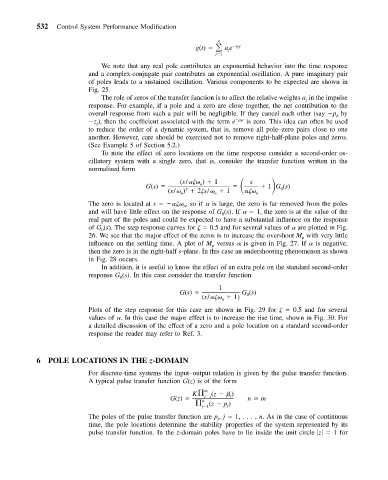Page 541 - Mechanical Engineers' Handbook (Volume 2)
P. 541
532 Control System Performance Modification
g(t) ae pt j
n
j 1 j
We note that any real pole contributes an exponential behavior into the time response
and a complex-conjugate pair contributes an exponential oscillation. A pure imaginary pair
of poles leads to a sustained oscillation. Various components to be expected are shown in
Fig. 25.
The role of zeros of the transfer function is to affect the relative weights a in the impulse
j
response. For example, if a pole and a zero are close together, the net contribution to the
overall response from such a pair will be negligible. If they cancel each other (say p by
k
z ), then the coefficient associated with the term e pt k is zero. This idea can often be used
j
to reduce the order of a dynamic system, that is, remove all pole–zero pairs close to one
another. However, care should be exercised not to remove right-half-plane poles and zeros.
(See Example 5 of Section 5.2.)
To note the effect of zero locations on the time response consider a second-order os-
cillatory system with a single zero, that is, consider the transfer function written in the
normalized form
(s/
) 1 s 1 G (s)
G(s) n
(s/ ) 2
s/ 1
n 0
2
n
n
The zero is located at s
,soif is large, the zero is far removed from the poles
n
and will have little effect on the response of G (s). If 1, the zero is at the value of the
0
real part of the poles and could be expected to have a substantial influence on the response
of G (s). The step response curves for
0.5 and for several values of are plotted in Fig.
0
26. We see that the major effect of the zeros is to increase the overshoot M with very little
p
influence on the settling time. A plot of M versus is given in Fig. 27. If is negative,
p
then the zero is in the right-half s-plane. In this case an undershooting phenomenon as shown
in Fig. 28 occurs.
In addition, it is useful to know the effect of an extra pole on the standard second-order
response G (s). In this case consider the transfer function
0
1
G(s) G (s)
(s/
1) 0
n
Plots of the step response for this case are shown in Fig. 29 for
0.5 and for several
values of . In this case the major effect is to increase the rise time, shown in Fig. 30. For
a detailed discussion of the effect of a zero and a pole location on a standard second-order
response the reader may refer to Ref. 3.
6 POLE LOCATIONS IN THE z-DOMAIN
For discrete-time systems the input–output relation is given by the pulse transfer function.
A typical pulse transfer function G(z) is of the form
K m (z )
G(z) i 1 i n m
n (z p )
j 1 j
The poles of the pulse transfer function are p , j 1,..., n. As in the case of continuous
j
time, the pole locations determine the stability properties of the system represented by its
pulse transfer function. In the z-domain poles have to lie inside the unit circle z 1 for

